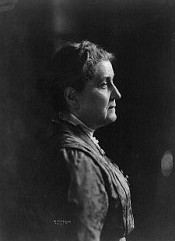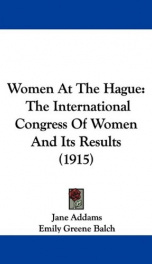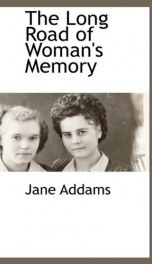Addams Jane

Jane Addams (September 6, 1860 – May 21, 1935) was a founder of the U.S. Settlement House movement, and the second woman to be awarded the Nobel Peace Prize. Born in Cedarville, Illinois, Jane Addams was the youngest of six children born into a prosperous, loving family.[1] Although she was the eighth child, two of her siblings died in infancy, leaving only six to mature.[2] Her mother, Sarah Addams (née Weber), died from tuberculosis during pregnancy when Jane was just two years old. Jane's father, John H. Addams, was the President of The Second National Bank of Freeport, an Illinois State Senator from 1854 to 1870, and owner of the local grain mill. He remarried when Jane was eight. Her father also was a founding member of the Republican Party and supported Abraham Lincoln. Jane was a first cousin twice removed to Charles Addams, noted cartoonist for The New Yorker.[3] She was born with Pott's disease, which caused a curvature of her spine and lifelong health problems. Addams's father encouraged her to pursue a higher education, but not at the expense of losing her femininity and the prospect of marriage and motherhood, as expected of upper class young women. She was educated in the United States and Europe, graduating from the Rockford Female Seminary (now Rockford College) in [Rockford, Illinois]. After Rockford, she spent seven months at the Women's Medical College of Philadelphia, but dropped out. Her parents felt that she should not forget the common path of upper class young women. After her father's sudden death, Addams inherited $50,000. In 1885, she set off for a two-year tour of Europe with her stepmother. Upon her return home, she felt bored and restless, indifferent about marriage, and wanting more than just the conventional life expected of well-to-do ladies. After painful spinal surgery, she returned to Europe for a second tour in 1887, this time with her best friend Ellen Starr and a teacher friend. During her second tour, Addams visited London's Toynbee Hall, which was a settlement house for boys based on the new philosophy of charity. Toynbee Hall was Addams's main inspiration for Hull House. Throughout her life Addams was close to many women and was very good at eliciting the involvement of women from different classes in Hull House's programs. Her closest adult companion and friend was Mary Rozet Smith, who supported Addams's work at Hull House, and with whom she shared a romantic friendship. Together they owned a summer house in Bar Harbor, Maine[4][5][6][7][8] According to one biographer Addams was raised as a Quaker but joined a Presbyterian church in Chicago and maintained her membership there as an adult. In 1889 she and her college friend, Ellen Gates Starr,[9] co-founded Hull House in Chicago, Illinois, the first settlement house in the United States. The house was named after Charles Hull, who built the building in 1856. When starting out, all of the funding for the Hull House came from the $50,000 estate she inherited after her father died. Later, the Hull House was sponsored by Helen Culver, the wealthy real estate agent who had initially leased the house to the women.[10] Jane and Ellen were the first two occupants of the house, which would later be the residence of about 25 women. At its height, Hull House was visited each week by around 2000 people. Its facilities included a night school for adults, kindergarten classes, clubs for older children, a public kitchen, an art gallery, a coffeehouse, a gymnasium, a girls club, bathhouse, a book bindery, a music school, a drama group, a library, and labor-related divisions. Her adult night school was a forerunner of the continuing education classes offered by many universities today. In addition to making available services and cultural opportunities for the largely immigrant population of the neighborhood, Hull House afforded an opportunity for young social workers to acquire training. Eventually, the Hull House became a 13-building settlement, which included a playground and a summer camp (Bowen Country Club). The Hull House neighborhood was a mix of various European ethnic groups that had immigrated to Chicago beginning at the turn of the nineteenth/twentieth century. The Bethlehem-Howard Neighborhood Center Records memorializes that mix of immigrants that made up the social laboratory upon which the social and philanthropic elitists comprising Hull House's inner sanctum tested their theories and based their challenges to the establishment. "Germans and Jews resided south of that inner core (south of Twelfth Street)…The Greek delta formed by Harrison, Halsted, and Blue Island Streets served as a buffer to the Irish residing to the north and the Canadian–French to the northwest."[11] Italians resided within the inner core of the Hull House Neighborhood...from the river on the east end, on out to the western ends of what came to be known as Little Italy.[12] Greeks and Jews, along with the remnants of other immigrant groups, began their exodus from the neighborhood during the early part of the 20th century. The Italians were the only ethnic group that continued as a thriving community through the Great Depression, World War II and well beyond the ultimate demise of Hull House proper in 1963. Taylor Street Archives: Florence Scala The harsh criticism received by Addams, both for her outspoken pacifism during World War I and her defense of immigrants' civil rights during a period when anarchism and socialism were greatly feared in the United States, never stopped her from putting forth a great amount of effort and energy into Hull House. She even had the time to work on international peace efforts. She spoke and campaigned extensively for Theodore Roosevelt's 1912 Presidential campaign on the Progressive Party. Jane was elected president of the Women's International League for Peace and Freedom, a position that entailed frequent travel to Europe (both during and after World War I) and Asia. During World War I, Addams faced harsh rebukes and criticism as a pacifist. Her speech on pacifism at Carnegie Hall received negative coverage by newspapers such as the New York Times, which branded her as unpatriotic. This was a difficult time for Jane Addams. Later, during her travels, she would spend time meeting with a wide variety of diplomats and civic leaders and reiterating her Victorian belief in women's special mission to preserve peace. Recognition of these efforts came with the award of the Nobel Peace Prize to Addams in 1931. As the first U.S. woman to win the prize, Addams was applauded for her "expression of an essentially American democracy." Hull House and the Peace Movement are widely recognized as the key tangible pillars of Addams' legacy. While her life focussed on the development of individuals, her ideas continue to influence social, political and economic reform in the United States as well as internationally. Theories developed by Pulitzer Prize winners Jared Diamond (Fates of Societies) and E. O. Wilson (On Human Nature) both drew upon Addams' hypothesis that physical and social landscapes can influence the fate of subcultures. Willard Motley, a resident artist of Hull House, extracting from Addams' central theory on symbolic interactionism, used the neighborhood and its people to write his 1948 best seller, Knock on Any Door.[13] Addams' role as reformer enabled her to petition the establishment and alter the social and physical geography of her Chicago neighborhood. Although contemporary academic sociologists defined her engagement as "social work," Addams' efforts differed significantly from activities typically labeled as "social work" during that time period. Before Addams' powerful influence on the profession, social work was largely informed by a "friendly visitor" model in which typically wealthy women of high public stature visited impoverished individuals and, through systematic assessment and intervention, aimed to improve the lives of the poor. Addams rejected the friendly visitor model in favor of a model of social reform/social theory-building, thereby introducing the now-central tenets of social justice and reform to the field of social work.[14] Hull House enabled Addams to befriend and become a colleague to early members of the Chicago School of Sociology. Her influence, through her work in applied sociology, impacted their thoughts and their direction. In 1893, she co-authored the Hull-House Maps and Papers that came to define the interests and methodologies of the School. She worked with George H. Mead on social reform issues including promoting women's rights, ending child labor, and mediating during the 1910 Garment Workers' Strike. Addams worked with labor as well as other reform groups toward goals including the first juvenile-court law, tenement-house regulation, an eight-hour working day for women, factory inspection, and workers' compensation. She advocated research aimed at determining the causes of poverty and crime, and supported women's suffrage. She was a strong advocate of justice for immigrants and blacks, becoming a chartered member of the NAACP. Among the projects that the members of the Hull House opened were the Immigrants' Protective League, the Juvenile Protective Association, the first juvenile court in the United States, and a Juvenile Psychopathic Clinic. Addams' writings and speeches, on behalf of the formation of the League of Nations and as peace advocate, are well documented; influencing the later shape of the United Nations. In 2007, a joint resolution of the Illinois General Assembly renamed the Northwest Tollway as the Jane Addams Memorial Tollway.[15] Jane Addams House is a residence hall built in 1947 at Connecticut College. Hull House had to be demolished for the establishment of the Chicago campus of the University of Illinois in 1963 and relocated. The Hull residence itself was preserved as a monument to Jane Addams. Jane Addams Business Careers Center is a high school in Cleveland, Ohio. The Jane Addams Trail is a bicycling, hiking, snowmobiling, and cross country skiing trail which stretches from Freeport, Illinois to the Wisconsin state line. It is 12.85 miles (20.68 km) long, and is part of the larger Grand Illinois Trail, which is over 575 miles (925 km) long.[16] The trail is located near her birthplace of Cedarville, Illinois.[17]
do you like this author?
What readers are saying
What do you think? Write your own comment on this book!
write a commentWhat readers are saying
What do you think? Write your own comment on this author!
write a commentBook list

women at the hague the international congress of women and its results
Series:
Unknown
Year:
Unknown
Raiting:
2.5/5
In the midst of World War I, from April 28 to May 1, 1915, more than a thousand women from Europe and North America gathered in The Hague to discuss proposals for a peaceful end to the war. As one of the founders of the Woman's Peace Party, Jane Addams was among the attendees at the International Congress of Women, along with fellow social reformers and peace activists Emily G. Balch and Alice Hamilton. This book contains their journalistic accounts of the Congress's proceedings and results as well as their personal reflections on peace, war, politics, and the central role of women in the preservation of peace. Following the conference in The Hague, Addams and Balch traveled around Europe as members of delegations visiting various governmental leaders to demand an end to the war. In this book they describe the activities of these delegations, painting a vivid portrait of the emerging women's peace movement. With the continuing growth of the peace movement, the essays in Women at the Hague remain as timely as they were when first published in 1915. Addams, Balch, and Hamilton write compellingly about the organizing methods and collaborative spirit of the women's peace movement, conveying a strong awareness of the responsibility of women to protect the global community from the devastating effects of war. --This text refers to the Hardcover edition.
Show more
add to favoritesadd In favorites

the long road of womans memory
Series:
Unknown
Year:
Unknown
Raiting:
3/5
The Shelf2Life Women
Show more
add to favoritesadd In favorites
Book list

women at the hague the international congress of women and its results
Series:
Unknown
Year:
Unknown
Raiting:
2.5/5
In the midst of World War I, from April 28 to May 1, 1915, more than a thousand women from Europe and North America gathered in The Hague to discuss proposals for a peaceful end to the war. As one of the founders of the Woman's Peace Party, Jane Addams was among the attendees at the International Congress of Women, along with fellow social reformers and peace activists Emily G. Balch and Alice Hamilton. This book contains their journalistic accounts of the Congress's proceedings and results as well as their personal reflections on peace, war, politics, and the central role of women in the preservation of peace. Following the conference in The Hague, Addams and Balch traveled around Europe as members of delegations visiting various governmental leaders to demand an end to the war. In this book they describe the activities of these delegations, painting a vivid portrait of the emerging women's peace movement. With the continuing growth of the peace movement, the essays in Women at the Hague remain as timely as they were when first published in 1915. Addams, Balch, and Hamilton write compellingly about the organizing methods and collaborative spirit of the women's peace movement, conveying a strong awareness of the responsibility of women to protect the global community from the devastating effects of war. --This text refers to the Hardcover edition.
Show more
add to favoritesadd In favorites

the long road of womans memory
Series:
Unknown
Year:
Unknown
Raiting:
3/5
The Shelf2Life Women
Show more
add to favoritesadd In favorites

the clash in nevada a history of womans fight for enfranchisement the nevada
Series:
Unknown
Year:
Unknown
Raiting:
3.5/5
Show more
add to favoritesadd In favorites

Twenty Years at Hull House; with autobiographical notes
Series:
Unknown
Year:
Unknown
Raiting:
5/5
Show more
add to favoritesadd In favorites

The Spirit of Youth and the City Streets
Series:
Unknown
Year:
Unknown
Raiting:
2.5/5
Jane Addams is a famous novelist who also was the female leader of Louis Menand's The Metaphysical Club. Her famous novel The Spirit of Youth and the City Streets is recognized both by literary critics and by readers. All the pages of the book are full with a number of touching moments some of which even make readers cry. The book influenced a lot of generations opening their eyes on the reality of the modern world.
Show more
add to favoritesadd In favorites

A New Conscience and an Ancient Evil
Series:
Unknown
Year:
Unknown
Raiting:
1.5/5
Purchase of this book includes free trial access to www.million-books.com where you can read more than a million books for free. This is an OCR edition with typos. Excerpt from book: CHAPTER U RECENT LEGAL ENACTMENTS At the present moment even the least conscientious citizens agree that, first and foremost, the organized traffic in what has come to be called white slaves must be suppressed and that those traffickers who procure their victims for purely commercial purposes must be arrested and prosecuted. As it is impossible to rescue girls fraudulently and illegally detained, save through governmental agencies, it is naturally through the line of legal action that the most striking revelations of the white slave traffic have come. For the sake of convenience, we may divide this legal action into those cases dealing with the international trade, those with the state and interstate traffic, and the regulations with which the municipality alone is concerned. First in value to the white slave commerce is the girl imported from abroad who from the nature of the case is most completely in the power of the trader. She is literally friendless and unable to speak the language and at last discouraged she makes no effort to escape. Many cases of the international traffic were recently tried in Chicago and the offenders convicted by the federal authorities. One of these cases, which attracted much attention throughout the country, was of Marie, a French girl, the daughter of a Breton stone mason, so old and poor that he was obliged to take her from her convent school at the age of twelve years. He sent her to Paris, where she became a little household drudge and nurse-maid, working from six in the morning until eight at night, and for three years sending her wages, which were about a franc a day, directly to her parents in the Breton village. One afternoon, as she was buying a bottle of milk at a tiny shop, she was engaged in conversation by a young man who invit... --This text refers to an alternate Paperback edition.
Show more
add to favoritesadd In favorites
What readers are saying
What do you think? Write your own comment on this author!
write a commentGenre
- Arts & Photography / Performing Arts / Theater / General
- Books / African Americans
- Books / Prostitution
- Books / Child rearing
- Books / Addams, Jane,1860-1935
- Literature & Fiction / Classics
- Law / United States
- Nonfiction / Education / Education Theory / History
- Books / Gladstone, W. E. / (William Ewart),1809-1898
if you like Addams Jane try:
readers also enjoyed
What readers are saying
What do you think? Write your own comment on this author!
write a commentGenre
- Arts & Photography / Performing Arts / Theater / General
- Books / African Americans
- Books / Prostitution
- Books / Child rearing
- Books / Addams, Jane,1860-1935
- Literature & Fiction / Classics
- Law / United States
- Nonfiction / Education / Education Theory / History
- Books / Gladstone, W. E. / (William Ewart),1809-1898
if you like Addams Jane try:
readers also enjoyed
Do you want to exchange books? It’s EASY!
Get registered and find other users who want to give their favourite books to good hands!

